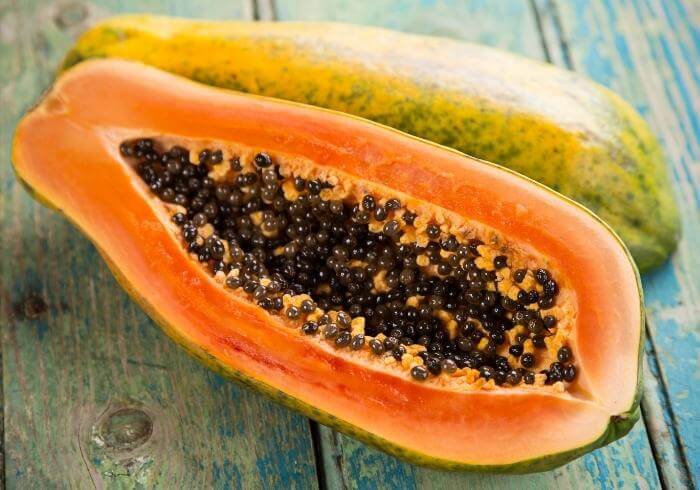Is that papaya in your fruit bowl looking a little worse for wear? Before you slice it, it’s important to know when papaya has gone bad, so you don’t get sick.
When papaya goes bad, it starts to smell, become mushy, and discolored, and may grow mold. Eating rotten papaya can make you sick, so if you notice any of these signs of spoilage, it’s time to throw it out.

So, let’s look at some signs that your papaya is no longer fresh and past its prime.
How To Know If Papaya Is Bad
It Smells Bad
A bad-smelling papaya is often the result of bacteria breaking down the papaya and fermenting it. It has all the ingredients spoilage bacteria need to thrive, including moisture and sugars.
Some people dislike the musk smell of ripe papaya. So if you believe your papaya is still good but a little stinky, it may be fine.
The bad smell that some report is caused by an enzyme called papain that breaks down proteins. Papain is used in tenderizers and can help to break down tough meat fibers, making it easier to chew.
When papain comes into contact with air and your nose, it causes that characteristic odor. And papayas also contain other volatile compounds that can act as irritants, further contributing to the unpleasant smell.
If your papaya has a fermented smell, then it is best to throw it out or compost it. If you’re unsure, check to see if there are other signs of spoilage. Quite often, a bad smell accompanies mushy papaya.
It Is Mushy
When papaya ripens, it will start to become soft. This is good because it helps notify you that its flavor is peaking.
However, when it becomes too soft or mushy, it’s no longer fresh, and the flavor will take a drastic turn from delicious to yucky.
Mushy sections on papaya can be caused by bruising, bacteria, or simply being overripe.
If a small section of your papaya is mushy from bruising, you should be able to cut off the bad section and save the rest of the fruit. Just make sure you cut off an extra 2 inches of good papaya to ensure that you’ve removed all of the mush.
Mushy, overripened, or decomposing papaya should not be used. Unfortunately, these are too far gone to eat and should be thrown out. Besides, it won’t taste good at all, no matter how you plan to use it, and it could make you sick.
It Is Discolored
A discolored papaya is a sign that it is likely bad. When the skin changes color, you will often find that the flesh becomes extremely soft at the same time.
Depending on the species and how far along the ripening process is, a good papaya’s skin should fade from green to yellow or orange and may have hints of orange or red.
If your papaya has started to turn brown or black, it is decomposing and no longer safe to eat.
There Are Black Spots
Not to be confused with black papaya seeds, black spots may indicate fungal infection with the fruit, which according to Gardening Know How is harmless when eaten. Of course, you should avoid eating it regardless.
A few black spots are fine, but if your papaya is completely peppered with black spots, it’s probably best to avoid using it.
But wait a minute, are the black spots from a fungus or from mold?
There Is Mold
Mold takes on a variety of colors, including white, blue, green, and black. And it can appear on the surface of your papaya as a fuzzy growth, but not always.
It doesn’t matter if you see mold on only one section of the papaya because mold has long roots that aren’t visible to see. It’s likely that the mold has spread throughout the papaya, so it’s best to discard it.
And if other fruits or vegetables have been stored with your papaya, mold spores may have started to grow on them as well, so you should inspect and toss any affected produce.
Bad Papaya FAQs
Can You Eat A Papaya That Has Black Spots?
Yes, you can eat papaya that has black spots as long as it’s only skin deep and is not the result of mold. The fungus responsible for the black spots is harmless to most people, but consumption should be avoided to be safe.
Is The White Stuff On My Papaya Bad?
The white stuff on papaya is papaya sap, where a lot of papain is contained. This sap is safe to eat and is often used as a meat tenderizer.











